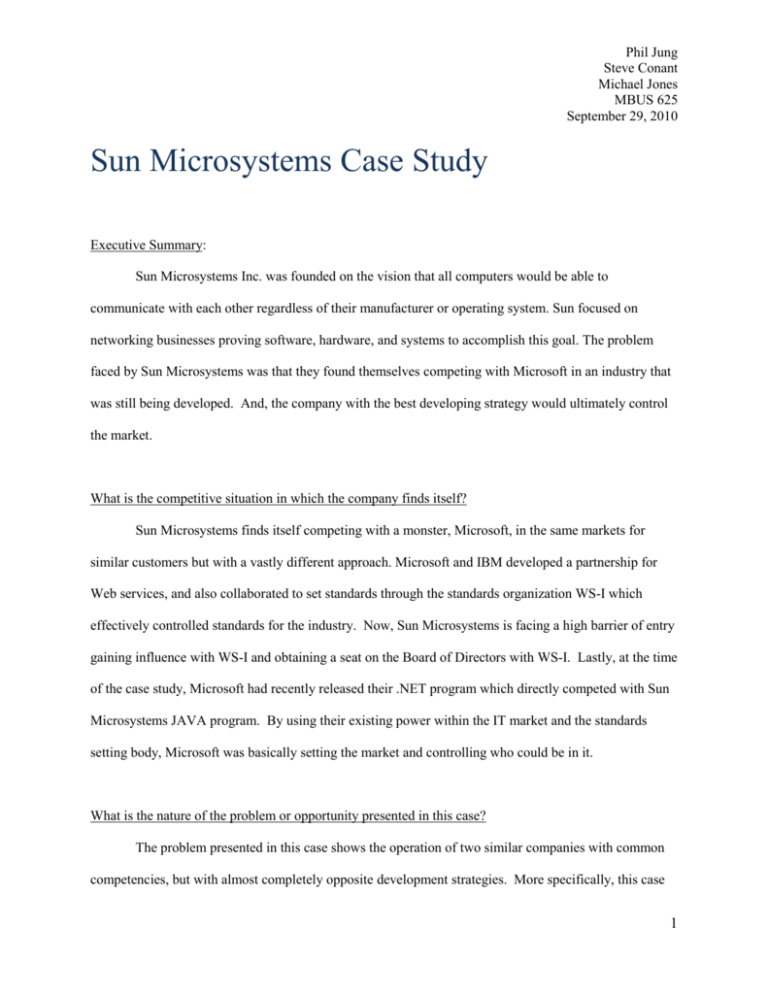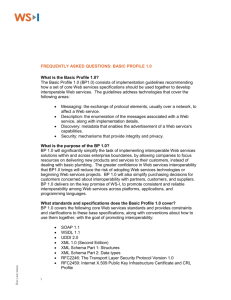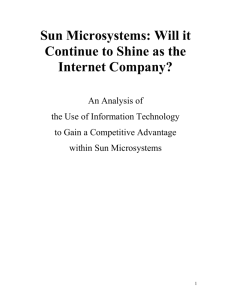MBUS626-G2-Sun Microsystems
advertisement

Phil Jung Steve Conant Michael Jones MBUS 625 September 29, 2010 Sun Microsystems Case Study Executive Summary: Sun Microsystems Inc. was founded on the vision that all computers would be able to communicate with each other regardless of their manufacturer or operating system. Sun focused on networking businesses proving software, hardware, and systems to accomplish this goal. The problem faced by Sun Microsystems was that they found themselves competing with Microsoft in an industry that was still being developed. And, the company with the best developing strategy would ultimately control the market. What is the competitive situation in which the company finds itself? Sun Microsystems finds itself competing with a monster, Microsoft, in the same markets for similar customers but with a vastly different approach. Microsoft and IBM developed a partnership for Web services, and also collaborated to set standards through the standards organization WS-I which effectively controlled standards for the industry. Now, Sun Microsystems is facing a high barrier of entry gaining influence with WS-I and obtaining a seat on the Board of Directors with WS-I. Lastly, at the time of the case study, Microsoft had recently released their .NET program which directly competed with Sun Microsystems JAVA program. By using their existing power within the IT market and the standards setting body, Microsoft was basically setting the market and controlling who could be in it. What is the nature of the problem or opportunity presented in this case? The problem presented in this case shows the operation of two similar companies with common competencies, but with almost completely opposite development strategies. More specifically, this case 1 outlines the different strategies employed by each corporation in order to gain a larger share of the market. Draw and describe how can the Information Systems Triangle be employed in this case. Business Strategy Organizational Strategy Corporation headquartered in Silicone Valley with a strong focus on R&D. This organizational strategy employs an “Open” approach which allows the company to innovate and benefit from the work and ideas of developers not directly employed by the company. Create an e-business atmosphere that allows all devices to communicate with on another regardless of manufacturer, Operating System, Software or programming language. Provide useful platforms and software that are available for use through payment of royalties. IT Strategy There is a strong focus on R&D along with development of the “Open” platform while maintaining licensing for improvements. What is your recommendation to the management team for improving the company’s competitve advantage? One business strategy that Sun Microsystems could try is that of co-opetition where they could ally themselves with a computer hardware company such as Dell, or another hardware company that seems to be on the rise. Sun was able to achieve the success due to their unique product which fulfilled the customers’ needs. Moving forward, the R&D department is the most important department which could lead to future business, so extending the budget on R&D would hopefully create some new, worthy innovations thus increasing their competitive advantage in the technical market. Another recommendation would be to not spend too much of their energy on the lawsuit with Microsoft. Instead, stay focused on adding value to current competitive advantages. What lessons have you learned from this case? 2 This case has shown that the web service industry may be fairly easy to enter; however, awakening a sleeping giant such as Microsoft will create many difficult and unpredictable battles. The “tight grip” strategy used by Microsoft in the forming of the WS-I worked to effectively hold out competition from Sun Microsystems, but Sun was eventually allowed to join the Board of Directors in 2004. Even though they found themselves in a cut-throat market, Sun survived the situation through court battles and their innovative R&D which later flipped one of their weaknesses to create opportunity by expanding into the web security sectors of the market. 1. Do you project strong growth for Web services? What types of companies are most likely to deploy them, and for what applications? What are the main barriers to adoption? Yes, the growth of Web services should be expected to be very strong. With the internet and the capabilities associated with it basically being in its infancy stage, growth and change are about the only constants that can be expected. The case notes that “most industry analysts agreed that Web services could fundamentally change the market for enterprise software.”1 Almost any company could use Web services, but these services would be especially useful in large corporations which need to share information across many users. Also, the capability of Web services to provide software that allows a user to access and use information from a large database that is stored on a main server is a capability that any corporation would find useful. This would allow anybody with secured access to use the company’s information as needed, but without having the complete database on their hard drive. And, because the database is not stored on an individual’s hard drive, this information would be available, current, and as up-to-date as possible for anybody who has access to the database. The main barriers to adoption that were discussed in the case are the barriers related to standards that were yet to be created. These standards were set in place to allow multiple users, vendors, etc., to have a say in the way that systems were designed and implemented so as to make compatibility between systems as seamless, or user-friendly, as possible. But, because the standards were not already in place the process to get the needed approvals could not keep up with the pace of business. 3 2. Relative to Microsoft’s proprietary programming platform for Web services, .Net, what are the advantages and disadvantes of shared platform employed Java camp? Does the Java camp have a clear leader? Does it need one? The advantages of the Java camp was that Java camp had participation from “so many IT system vendors (which) fueled innovation and gave customers switching options.”2 Because there were so many users with ideas on how to change the product, the product was constantly bringing new and innovative solutions to business challenges. But, this openness and ability to change was probably one of the main disadvantages to Java camp as well. The disadvantage of the Java services was that it took a considerable amount of time to agree on a Java standard, “12 to 18 months”3 according to the case study. This was an amount of time that software developers could not afford to wait. While it appears that Sun was the leading company of Java camp, the actual leader was the open forum. This was probably one of the biggest factors which caused standard approval to take so long. When comparing this with the model which was employed by Microsoft, it appears that having a clear leader would have been a good idea in this case. Microsoft dictated to their end users what was being upgraded and when it was going to be upgraded. While this led to a monopolistic style of business, this seemed to keep customers always needing the newest available software whenever it was released. Rather than the slow but continual change of Java, Microsoft’s software releasing techniques allowed the newest version of their software to be received by all the end users at the same time. 3. Should we be surprised at cooperation between Microsoft and IBM? Why did they help found the Web Services Interoperability Organization (WS-I)? Is WS-I likely to be influential? The alliance between Microsoft and IBM should not be seen as a big surprise. Microsoft and Sun always seemed to be offering competing software in the same markets. But, there seemed to be a very distinct difference in business strategies between the two companies. Microsoft was very vertically integrated, keeping many of their core competencies in house and not sharing any of their competencies 4 with anybody. And, Sun was an open company that valued input from all users and implemented the changes whenever possible. Then, there was IBM. IBM at this time seemed to be mainly a hardware provider. So, whichever software company was providing the best profit opportunities to IBM was going to be the company that IBM chose to partner with. Because of Sun Microsystems declining revenues from 2001 to 2002, it seemed obvious to assume that Microsoft and IBM would be working hand in hand with Microsoft, which showed to be a stronger financial company that Sun Microsystems. It seemed like the founding of WS-I was another “Microsoft” move. WS-I was going to be a very influential player in the way the Web services market industry developed. By Microsoft being the company that dictated the standards that everybody else designed to, they would have the most compatibility between systems. With the most compatibility between systems, Microsoft’s software would be more user-friendly, thus making their software the most desirable by most users. So, by controlling the standards, they controlled the competition from market entrants as well as existing competitors, such as Sun. 4. Should Sun join WS-I as a contributing member? Lobby for a board seat? Boycott WS-I permanently? At first, I thought that Sun should not join as a contributing member and continue to fight this in the courts trying to prove that Microsoft had a monopoly. But this pursuit would probably be costly and not very time efficient. While winning the court case would prove Sun’s stance, losing it could prove even more costly to the company in terms of lost opportunity and customers. So, I think it would be best for WS-I to join as a contributing member. Sun can probably do as much damage to Microsoft from the inside as they can from the outside. If their ideas and thoughts are as innovative and powerful as they predict, then Sun should be able to persuade the minds of others within the community to back their view. Thus, with enough backing they may be able to sway the board on certain issues. And through this continued effort, they may even be able to win a seat on the board without needing a court appointment onto the WS-I Board of Directors. 5 Bibliography 1. Eisenmann, Thomas R., and Fernando Suarez. "Sun Microsystems, Inc.: Web Services Strategy." Sun Microsystems, Inc.: Web Services Strategy 095th ser. 9.805 (2006): p. 1. Coursepacks.xanedu.com. Web. 23 Sept. 2010. 2. Eisenmann, Thomas R., and Fernando Suarez. "Sun Microsystems, Inc.: Web Services Strategy." Sun Microsystems, Inc.: Web Services Strategy 095th ser. 9.805 (2006): 5. Coursepacks.xanedu.com. Web. 23 Sept. 2010. 3. Eisenmann, Thomas R., and Fernando Suarez. "Sun Microsystems, Inc.: Web Services Strategy." Sun Microsystems, Inc.: Web Services Strategy 095th ser. 9.805 (2006): 5. Coursepacks.xanedu.com. Web. 23 Sept. 2010. 6







